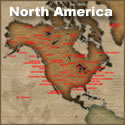North America's First Nations Tattoos
Most 19th Century
scholars took no interest in North American native tattooing and very little
information can be found. One scholar, A.T. Sinclair surveyed all the literature
written about tattooing and wrote a paper, "Tattooing of the American Indians"
which surveyed the records of tattooing in each geographical area of North
America.
17th Century French explorers and missionaries in Eastern Canada wrote some of
the most interesting description of tattooing in North American.
Gabriel Sagard-Theodat's account of tattooing among the Hurons, written in1615
reads:
But that which I find a most strange and conspicuous folly, is that in order to
be considered courageous and feared by their enemies (the Hurons) take the bone
of a bird or of a fish which they sharpen like a razor, and use it to engrave or
decorate their bodies by making many punctures somewhat as we would engrave a
copper plate with a burin. During this process they exhibit the most admirable
courage and patience. They certainly feel the pain, for they are not insensible,
but they remain motionless and mute while their companions wipe away the blood
that runs from the incisions. Subsequently they rub a black color or powder into
the cuts in order that the engraved marks which one sees on the arms of the
pilgrims returning form Jerusalem.
Numerous brief references to tattooing are found in writings of 17th century
Jesuit missionaries whose reports were sent to Paris each and compiled in
volumes titled, Jesuit Relations. Jesuit missions were scattered through Canada,
and missionaries reported that tattooing was practiced by almost all the native
tribes they encountered. In 1653, Francois-J. Bressani wrote:
In order to paint permanent marks on themselves they undergo intense pain. To do
this they use needles, sharpened awls, or thorns. With these instruments they
pierce the skin and trace images of animals or monsters, for example an eagle, a
serpent, a dragon, or any other figure they like, which they engrave on their
faces, their necks, their chess, or other parts of their bodies. Then, while the
punctures which form the designs are fresh and bleeding, they rub in charcoal or
some other black color which mixes with the blood and penetrates the wound. The
image is then indelibly imprinted on the skin. The custom is so widespread that
I believe that in many of these native tribes it would be impossible to find a
single individual who is not marked in this way. When this operation is
performed over the entire body it is dangerous, especially in cold weather. Many
have died after the operation, either as a result of a kind of spasm that it
produces, or for other reasons. The natives thus die as martyrs to vanity
because of this bizarre custom.
Native North American tattooing was often associated with religious and magical
practices. It was also used as a symbolic rite of passage at puberty ceremonies.
The Sioux, believed that after death the spirit of the warrior mounts a ghostly
horse and sets forth on its journey to the "many lodges" of the afterlife. Along
the way the spirit of the warrior meets an old woman who blocks his path and
demands to see his tattoos. I he has none, she turns him back and condemns him
to return to the world of the living as a wandering ghost.
Many tribes practiced therapeutic tattooing. The Ojibwa, tattooed the temples,
forehead, and cheeks of those suffering from headaches and toothaches that were
believed to be caused by malevolent spirits. Songs and dances that were supposed
to exorcise the demons accompanied the tattooing ceremony.
Tattooing was also used to honour warriors who had distinguished themselves by
bravery in combat. Other Europeans reported the use of tattooing to record
achievements in war. In the Jesuit Relations of 1663, it was reported that an
Iroquois chief known to the French as "Nero" bore on this thighs 60 tattooed
characters, each of which symbolized an enemy killed with his own hand.
There are few surviving illustrations of North American native tattoo designs.
Tattoo Museum Bibliography, Resources and Links
 See all North American Tattoo Culture Articles here
See all North American Tattoo Culture Articles here
Additional Resources
See the Lars Krutak article
America's Tattooed Indian Kings
for more
information about tattoos & tattooing among North America's First Nations.
North
America's Wichita Tribe -- Historical overview of the Wichita
people that includes mention of their tattooing practices
Marks of Transformation: Tribal Tattooing in California and the American Southwest
NEXT >>
Virginia and Florida
